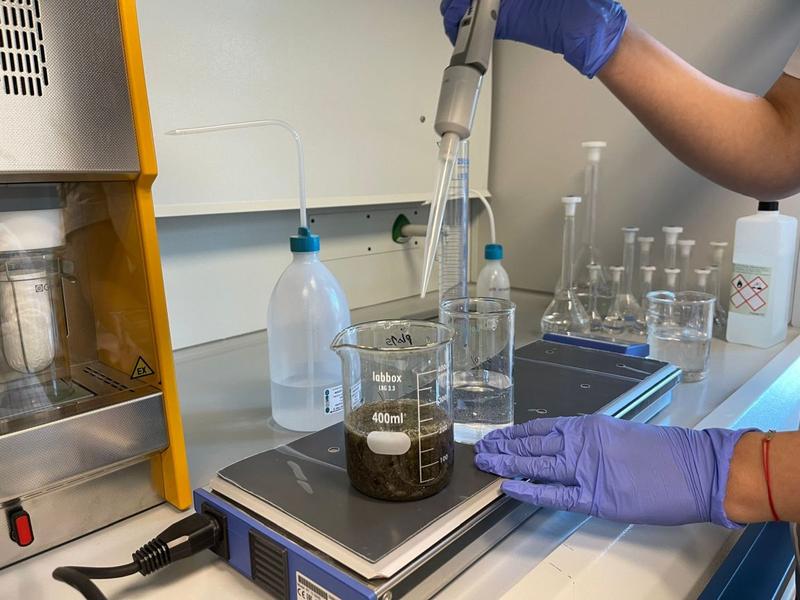Almost 100 tons of plastic are carried annually by the waters of the Danube on the territory of Romania. This is the conclusion of the first study on the amount of plastic transported by the Danube in our country, carried out during 2022-2023 by Mai Mult Verde associations and Global Water Partnership Romania. Microplastic represents almost half of the 100 tons. How…small is microplastic? How does he get to the Danube?
Laboratory analyzes for microplastic samplesPhoto: More Green
According to the study, the Romanian sector of the Danube annually transports, on average, 48.5 tons of microplastic and 48 tons of macroplastic. The highest annual transport yields were recorded at the Moldova Veche sampling station, close to the entrance of the Danube into Romania.
It is the most extensive study of this kind carried out in our country to date, being carried out during five consecutive seasons, during the spring-winter 2022 and spring 2023, in three sections on the Romanian route of the Danube: Old Moldova (km 23 after entrance to the territory of Romania), Gruia (downstream of the Iron Gates II) and Isaccea (after the last tributary – the Prut river, before the Danube Delta).
“Although the samples were taken in the conditions of a dry year (2022), with below-average flows, the results obtained are comparable to the values obtained by extrapolating to multi-year average flows. A continuous, multi-year monitoring is required, with a greater number of measurements on the main sections between the tributaries, in order to identify the dynamic evolution of the presence of microplastic particles in the Danube water, its sources and amelioration measures.” says Doru Mitrana, president of the Mai Mult Verde Association.
The results of the study regarding the presence of plastic materials in the Danube
During the study on the presence of plastic materials in the Danube, on the territory of Romania, the largest amounts of plastic transported by the river were recorded at the entrance to the country, near the town of Moldova Veche: between 93 and 100 tons/year of total plastic material, of which 46-51 tons/year microplastic, 47-49 tons/year macroplastic. Alluvium samples collected from the Old Moldova area contain several times higher amounts, both microplastic and macroplastic, compared to those collected in the Gruia and Isaccea areas.
Based on these results, it can be considered that the Portile de Fier I and II basins serve as an at least temporary accumulation and settling “reservoir” for plastic, so that after this area the recorded values decrease significantly and remain constant until the discharge into the Danube Delta .
According to the results of the study carried out by the Mai Mult Verde Association, the highest concentrations of microplastic were found at the surface of the water (up to 60 cm deep), but also at a greater depth, down to the bottom of the water. Microplastics are transported most likely fixed on mineral alluvium, flora and fauna, which has a major impact on the aquatic biosphere.
“This study is a support for government organizations that can direct efforts towards the prevention of microplastic pollution. At the same time, the information is relevant for the community of researchers and environmental activists, a community that can intervene through remedial activities or reaching this type of pollution. The entire food chain is affected by this type of pollution, and the consequences are diverse. The situation is serious and he must have acted responsibly.” says the coordinator of the study, Ionuț Procop – president of Global Water Partnership (GWP) Romania.
Where does microplastic in the Danube come from and how small is it?
Microplastic represents extremely small particles resulting from plastic, with a maximum size of 5 mm, and macroplastic represents particles with sizes between 5 mm and 2.5 cm. They grind over time, under the influence of abrasive and corrosive materials in the water, and turn into microplastic.
Regarding the compositional analysis of the microplastic collected in the study carried out by the Mai Mult Verde Association, the most frequently found polymers in the analyzed samples are polyethylene (52-86%) and polypropylene (12-26%).
Polyethylene was identified in all samples, in a proportion of 52-86%. This polymer is found in most food packaging and household products such as bags and containers. Polypropylene (present in most samples, in a proportion of 12-26%) is found in the composition of materials used to obtain products such as caps, plugs, household appliances, bars and pipes.
Other plastic polymers found in the waters of the Danube are: polystyrene (used in the production of insulating materials, packaging and disposable tableware), the EVA ethylene-vinyl-acetate copolymer (used in the production of insulating materials, adhesives, different types of hoses, shoes and packaging), cellulose (used in the food and pharmaceutical industry, but also in the production of various packaging) and polyurethane (mainly used as a thermal insulator, as a raw material in the furniture industry and in the production of paint, adhesives, packaging).



